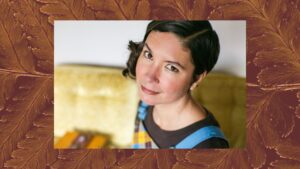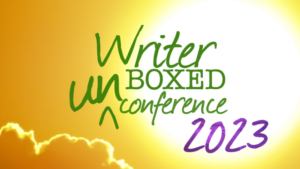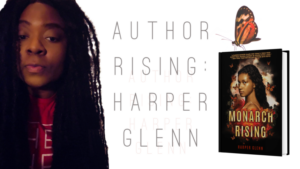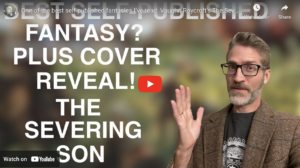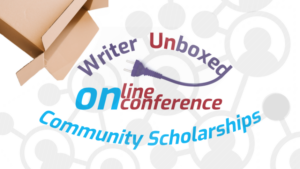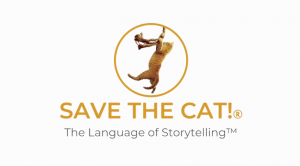Posts by Therese Walsh
UPDATE: There is now a GoFundMe link to benefit Susan’s family, including her young son. I hope you’ll click (HERE) and consider donating if you’re able.
I’m so very sorry to share that Writer Unboxed contributor, 2023 UnConference session leader, teacher, author, and vibrant human being Susan DeFreitas has passed away while undergoing treatment for cancer. She leaves behind not just a young family, but also her words—her novel, an anthology, and a legacy of encouragement, wisdom, and an unwavering belief in the power of storytelling through her many essays and classes.
A few years ago, I had yet to even meet Susan, but she left an imprint on me through her spirit, which I can only describe as doors-wide-open. She was here to see and interact and do. Author Nancy Johnson recently said that Susan was “on fire for truth,” and I think that’s exactly right. She was drawn to authenticity, to shining a light on marginalized voices, environmental issues, and injustice. She believed, deeply, in the lasting power of words—their ability to connect us across time and to build something that endures.
Today, I’m thinking about her 2023 UnConference session, Pleasure > Discipline. It was her final address of the conference, and there were no slideshows or notes, just Susan, speaking passionately about story and the writing life. She urged us to shed the myth that writing is about discipline and instead embrace the joy of creation and discovery—the deep personal gratification of shaping stories that matter.
At the end of her talk, she asked us to imagine a cathedral of books.
Picture your favorite book—the one that shaped you, the one you return to for study or pleasure. Now imagine placing that book in a stack, and beside it, another favorite, and another, and another—laying books like bricks until the stack grows into something vast and magnificent. This is a cathedral, built book by book, word by word, voice by voice.
She paused, then asked: Can you contribute a brick?
Susan laid many bricks—not just through her writing, but through the way she lifted others up and empowered their work. I think she’d be glad to know that her life’s work will continue to guide writers through the wisdom she’s left for us to discover, including via the recorded courses on her website.
Susan’s legacy will carry on. Her bricks will strengthen the foundation for us all. The cathedral will continue to rise.
And like every good cathedral, if you listen for it, you’ll hear an echo:
Contribute a brick…
Read More
My son lives in Los Angeles, and you’ll understand that while we’ve been watching the wildfires out there with horror for those experiencing immediate loss, we’ve also had heightened concern for our son. When he called to tell us that he’d received an evacuation order from the city, he also admitted he hadn’t yet packed a bugout bag. He had no time to listen to our volley of suggestions—“Don’t forget your passport!”—he had to move.
Ironically, two months prior, while moving into a new apartment, he lost a bag filled with—in his words—“everything I’d grab in a fire.” It was excruciating for him to digest the loss of these items, which were not of the passport variety. A denim 80s Guess jacket that belonged to his dad. A painting made by a loved one. The worn skateboard that saw him through college.
Chaos on the outside can cause chaos on the inside, of course. And so after that loss, he misplaced things he never normally would have, including a credit card. His mind had been elsewhere, you might assume, though he’s also wondered—only half-jokingly—if his new apartment is home to a poltergeist.
When the fire came, it was with this additional context. He knew that what you save in a fire goes beyond practicalities like “passport” and even beyond sentimental replacements, like the new old Guess jacket we’d given him for Christmas—a replica of the one he’d lost. And only he could decide what was worth saving.
So how do you decide what’s worth saving when you have limited time and space? And what, if anything, can you deduce from this when it comes to creating characters for your novel? Is there a way you can push your characters to reveal themselves through choices forged in fire?
Choices Forged in Fire
Moments of crisis can become a powerful lens that reveals character in a way few other situations can. That’s because the pressure to choose has a way of calling everyone’s bluff—revealing core values and hidden attachments beyond the easier-to-explore surface of character. It calls the author’s bluff too, as pushing a character into the fire can illuminate for you what’s important to them.
Imagine your protagonist faced with a literal fire, given only five minutes to choose what to save. Now ask yourself:
Read More
My mother has one of the so-called “superpower genes,” which boosted her capacity for resilience beginning in childhood. She likely needed it; her father fought against authoritarianism during WWII, earning a Purple Heart on Germany’s border.
I literally don’t have this gene. When confronted by threat, my impulse is to withdraw into a quiet, private space, away from others and even my art. It’s something I have to actively resist, which means I need to build resilience within myself, complementing my “nature” with some self-“nurture.”
But how?
Reach for an Anthem
It’s usually our friend Vaughn Roycroft who reaches for song lyrics, I know, but today I’m thinking of a song that’s long been a favorite of mine, “Love Don’t Go” by The Family Crest. There’s something about it that has always struck me as triumphant despite lyrics that can ride in the other direction. I’m writing with some new thoughts on that today as this earworm settles in with my permission and gratitude. (I’ve embedded the song at the bottom of this post, if you’d like to hear it first.)
So you lost your head inside your heart
And the weighty world it tore you apart
And you’ve all but given up
On the stone you call a heart, you’re singing out
If you’ve ever poured yourself into something you believed in, only to watch it falter, you’ll feel the truth in these lyrics about the weighty world’s effect on your spirit. When you care deeply about something and invest yourself in a cause that fails, it can feel like heartbreak. But in these moments of loss, there is also an invitation.
Sing it out
Creativity often finds its power when artists are driven to “sing it out”—to express pain, loss, or unfulfilled dreams through their craft. To use their struggles to add authenticity and depth to their work rather than retreat. Across generations, storytellers of all walks have transformed setbacks into fuel, finding purpose in the act of creating, despite life’s challenges.
Despite.
And because of.
My unquiet mind, even in the midst of [gestures to everything] nudged at me to use it. To see that the lens of my story, already large, could be larger yet. And what would that look like? An idea flooded in about the deeper roots in a dysfunctional system in my story, and I scrambled for a pen.
Oh, the love you’ve placed inside my hands
Oh, the fervor that your heart demands
Well we went off with a spark
But you were left out in the dark, singing out
Oh, sing it out
The gift of hard times for an artist is its nudge to recast what we thought we knew about the world and its people in order to bring a greater texture, power, and insight to our art. And the beauty of art, in part, lies in its ability to transform what’s heavy in our hearts into something even more authentic, which in turn can make it more relatable and even bridge divides.
Oh, love, you wanna step outside
Find a place to run and hide
It isn’t that it’s tough
It’s just that I don’t love you enough
Clouds will cast a shadow—it’s simply physics. Likewise, dark times can make us question the value of what […]
Read MoreThe creation of fictional worlds with tight internal logic and vivid details that bring them to life. Characters who feel so real we care what happens to them. Storylines that cause laughter, tears, disbelief, and the ability to consume our attention—even blur the line between fantasy and reality.
Am I describing novelists/novels here or politicians/politics? Probably both, here in 2024.
I’m sure I’m not the only one who’s noticed similarities between the methods we use to create fiction and the tools of mass manipulation some politicians lean on these days. So while it might seem like they’ve been stealing from our playbook, let’s see if we might learn a thing or two from them.
Understand Who Wields Control and How Information Moves
In today’s world, control of information is one of the most powerful tools available to those with a platform–and political figures (and owners of social-media companies) have some of the biggest around. The combination of platform and a person’s character matters a whole lot. A caring person on a big platform can do much good–shout out to Oprah Winfrey–but a self-serving person on a big platform can do a lot of harm. Whether it’s cherry-picking facts, distorting statistics, or repeating the same selective or false narrative until dissenters are either drowned out or start nodding in agreement, those who hold power often manipulate information to twist fact and fate to their favor, and to maintain control.
How to use it: To make control dynamics feel authentic in your wip, consider how information moves in your fictional world and where the power lies–the people who hold sway with others, the community leaders, the fire-starters. Who presents themselves as a hero when they’re really manipulating the narrative for their gain? Who benefits from the way things are, and who stands to lose if the status quo is upended?
It’s not only likely you have one potential power dynamic in your manuscript but several. If you struggle to find them, look for relationships between players of unequal power. This might be as common as a parent-child relationship or as unique as one between an animal trainer and an elephant. Now ask yourself if the inequality there is being utilized or neutralized. Unless the person/player with influence is genuinely a Switzerland of your story, you may have left some power plays on the table.
If you do have a character who in some way abuses authority, be sure to spend some time considering the why of it, as thin or no motivation here can deliver a thin character. Some possible motivations include consolidating or maintaining power; attracting allies; suppressing opposition or progress; providing others with a narrative so they don’t think critically for themselves; simplifying complex issues into black-and-white terms and suppressing nuance; distracting others from their own flaws or vulnerabilities; preventing harm to something they value, including themselves; and financial or other personal gains.
Try it: Draft a scene where a character discovers that something they’ve believed their whole life was a carefully constructed lie. What information was withheld from them, and who controlled it? How does the revelation change the course of the story?
Divide to Conquer
Division is one of the most powerful tools in a manipulator’s arsenal. It’s easier to maintain control over people when […]
Read MoreIt’s hard to believe that Writer Unboxed has been online for over 18 years now, but it has. We were barely into our second year when we received a nod from Writer’s Digest in their June 2007 issue for being one of the best 101 websites for writers. Just this month, we received our 18th such nod from Writer’s Digest. The site has evolved tremendously since 2006, when fellow co-founder Kathleen Bolton and I blogged most days alone, reaching far and wide to interview agents, editors, and authors–eager to learn, to share, and to build a community.
Today, Writer Unboxed is a true group effort, with over 60 respected voices offering empowering and often inspiring essays on the craft and business of fiction. A big hat tip to the entire team, with special thanks to 9 foundational contributors: assistant editors Kim Bullock and Vaughn Roycroft, and monthly contributors David Corbett, Kathryn Craft, Dave King, Donald Maass, Greer Macallister, Ray Rhamey, and Densie Webb.
Beyond the contributions of our team are each of your voices — the WU Community — which also received a deserved shout-out in this year’s WD award recap:
“For nearly two decades, Writer Unboxed has sought to publish empowering and positive ideas about the craft and business of fiction from more than 50 60 contributors. Known for its robust and supportive comment section, (Writer Unboxed) offers insights from editors, bestselling and up-and-coming authors, industry professional, and more.”
Congratulations to everyone for being a bright light here and on a job very well done. You’ve not only touched leagues of writers who turn to you for guidance, for fuel, and for community, you’ve inspired me to write on as well. Thank you for that.
To the next page, friends!
~ Therese
p.s. Click to view the full post for photos!
p.p.s. You can purchase a signed copy of the only Writer Unboxed book, Author in Progress, at one of our favorite independent book stores: WICKED GOOD BOOKS in Salem, MA. Click HERE.
Read MoreUnless you’ve been living in another solar system, you’re probably aware that there is an eclipse coming to a sky near you on April 8th. My hometown lies in a zone with 98% coverage — meaning 98% of the sun will be eclipsed during the event — and so roughly 98% of local news here is about the eclipse. (This is only a mild exaggeration. There are highway signs lit 24/7 inviting folks passing through to come back and spend the day here on 4/8. We are a bit obsessed.)
Considering the saturated state of the news on this topic, I didn’t think anything beyond incredulity inspired me to click over to read David Baron’s recent article titled “How the eclipse might heal our tattered nation.” Baron, a former chair in astrobiology at the Library of Congress and the author of American Eclipse: A Nation’s Epic Race to Catch the Shadow of the Moon and Win the Glory of the World, is even more obsessed with eclipses than my local news outlets; he’s chased eight eclipses across five continents thus far.
“A total eclipse can be life-changing,” he writes, then goes on to describe witnessing his first (Aruba, 1998):
“At the instant the moon fully covered the sun and the blue sky fell away, the solar corona — the sun’s outer atmosphere — burst forth, shimmering like a tinsel wreath in outer space. Beside it, the planets sailed in their orbits. The sight was a revelation, for I understood viscerally that I am a mere speck on a piece of rock drifting around the sun.”
Eclipses have inspired more than awe, they’ve also altered the course of history, Baron says — and here I went down a rabbit hole, reading several articles about how eclipses have affected ancient history, American history, and even scientific theory. Indeed, Einstein’s Theory of Relativity was supported during the eclipse of 1919, when some stars appeared out of place in the sky — evidence that the sun’s gravity had bent the path of light.
Janna Levin, whose voice is heard narrating the video above, is a physics and astronomy professor at Barnard College of Columbia University and author of Black Hole Blues and Other Songs from Outer Space. In her video, she describes how Englishman Sir Arthur Eddington’s work during the eclipse helped to prove German citizen Albert Einstein’s theory on the heels of WW1. These were “discoveries that transcended political animosity and nationalism fermented by the Wars. Eddington, unlike some of his compatriots, had no urge to denigrate Einstein’s accomplishments, although he was a citizen of a country so recently a bitter enemy… Out of the shadow of the war into the shadow of the moon, they were citizens of the same earth.”
Oof, isn’t that gorgeous?
Considering “The Dark Day of the Sky” as Fodder for the Novelist
While contemplating all of this, my mind drifted to “the dark night of the soul,” which has taken its place in the writing world, and come to mean a profound existential and/or psychological crisis that leads to transformation within a person. What if an eclipse or other worldly event could deliver […]
Read MoreThis is not a post to share an Eventbrite link or session lineup for the next in-person UnConference in Salem, MA. That exciting roundup and public link will drop here on Thursday.
Update: That link is HERE.
This IS a post telling you why I structured this November’s UnConference the way that I did and why I gave it the name that I did: ALL IN.
Theme
Sometimes ideas land for me all at once, and this was that kind of idea. I grabbed my phone and dictated rapidly into it. These are my actual, unedited notes, so forgive the scribble-sense of it.
Consider the effect of covid/existential crisis/loss/feeling mortal/how many minutes before midnight?/feeling that time is all we have—this moment, right now, so what will you do with it? No more waiting for inspiration, for a rainy day, for something to click, for someone or something to settle so that you can do what your bones and marrow call you to do, what you want desperately to do, what you were born to do. Today: Go “all in“ on your story, on your dreams, for your readership, for those who love and believe in you, for your community, for yourself. Because tick has never guaranteed tock. This is what we have. This moment right here. This incandescent present. So be present for it. Right now. Write now. Write on.
Later, I shared the notes with my husband, who gave me an enthusiastic thumbs up. “That’s it,” he said. “That’s what people need to hear.”
Hell, it’s what I needed to hear, and what I finally–finally–was coming to feel again. The desire to write. That little flame coming back. It needed fuel, and this conference would be THAT.
It took a little longer for my ideas to gel into structure.
Structure
While I knew I wanted to put on another UnConference, I hadn’t yet landed on some essential components, including how it would look and move throughout the week. These details are important, or at least are to me.
I began reviewing feedback from our past live events. We’d always had a 4-8 hour craft session on Friday, and some said they felt it was much for the last day, when they were already stuffed with ideas. The problem of overwhelm stuck with me.
So what if we pulled the longer workshop into the earlier part of the event? What if we broke things up in a different way?
Armed with sticky notes, I toyed with various scenarios, shifting longer craft-sessions-to-come into the Tuesday-Thursday afternoon schedule. Jan O’Hara, aware of my quandary, had a suggestion: Seat some of the longer craft sessions in the morning when people were freshest, their executive function reset. The idea grew on me. The sticky notes moved into new positions.
But The Friday Problem stood watching over my shoulder all the while.
Then it hit me, landed all at once again. The structure could be chaos-inspired. Because what have we been living these last many years if not chaos?
Our first sessions could help to create “good chaos”–shake things up, ask writers to consider things in a new way.
Ideas would, I imagined, float thick in the air like glitter in a disrupted snow globe. Mesmerizing. And in that state of awe and wonder, writers would be–ideally–more receptive to everything […]
Read MoreI’m thrilled to bring you today’s conversation/interview with debut author Harper Glenn. Harper and I met at the Writer’s Digest conference a few years back, and became fast friends. They’ve cheered me on when I’ve needed cheering, and I’ve cheered them right back. The way Harper spoke of their book idea and how it haunted them came to haunt me, too.
“Harper Glenn tackles themes of class and poverty, policing and protest, with nuance and empathy. A chilling glimpse at our future, Monarch Rising asks what we owe to the places that raise us—and insists that the answer must always be based in hope.”
—Kass Morgan, New York Times bestselling author of The 100
“Glenn’s impressive character-building presents a highly motivated, dynamically layered cast, driven by their respective trauma and desire for change.”
– Publishers Weekly
Please enjoy our deep-dive, free-style conversation, and thank you, Harper, for giving over so much time to it. It has been a pleasure.
TW: I think I remember the story of your debut, and that something came to you in a dream. Is that right? Can you explain what that was that you remember?
HG: Your memory is correct. :)…the concept for Monarch Rising came in a dream Fall 2016. In the dream, a young girl walked toward a forbidden bridge where a boy stood amazed, staring at her. “What are you doing?” the boy said. The girl wiped her tears. “I wanna see duh water.” “You need to go back.” the boy looked over his shoulder. “Why?” And then the boy said, “They’ll hang you if they catch you.” I woke up electrified, with chills, excited about the world I’d dreamt about. Who was this black girl? Who the hell was this white boy? Who was this “they” the boy referenced? And why the hell would they hang her for crossing a bridge? Why was she crying? I had to find out. That’s how Monarch Rising started.
TW: Gives me chills, too! So let’s talk about how you did this a little bit, if that’s okay with you. How do you turn a dream snippet into a book? Sounds like the first thing you did was mentally create that list of questions, yes? Where did you go from there? Did you flesh out THAT scene? Answer any of those specific questions first? Or did you work out characters?
HG: Everything begins and ends with questions. Questions ignite imagination. Imagination equates inspiration. And inspiration is everywhere. For Monarch Rising, inspiration started with a dream, and the questions that followed once I woke. But let’s say there wasn’t a dream or questions guiding inspiration.. how would I flesh out ideas? I select a memory, place, or thing and build a life around it. For example: I could write a story about Igne, a mafic rock. Igne’s nerdy sister is Chem. Igne’s reckless older brother is Canic. Where do Igne, Chem, and Canic live? On the upper mantle of Mars, socially suffocated by their strict parents, Sili-Ann and Intrusive Helium. Creativity is visible and invisible. So, focus on creating the world (grounded or imaginary). Envision the world so vividly, you can smell it, taste, touch it. Next, fill that world with extraordinary and eccentric, and […]
Read MoreWe usually wait to share book reviews for our interview days here at Writer Unboxed, but this morning our dear friend and one of my two extremely appreciated assistant editors, Vaughn Roycroft, received his first review. And I just can’t help but share it, and not just because I know how much heart and perseverance went into this series for Vaughn, but because I just can’t help but think YOU would also want me to share it as well.
Bonus: The FINAL cover is revealed at the end.
Email readers, you can access the YouTube video, titled, One of the best self-published fantasies I’ve read: Vaughn Roycroft’s The Severing Son, directly HERE.
Enjoy!
Read MoreI’m a dedicated fan of Carolyn Hax’s Washington Post advice column. Carolyn has a way of tunneling right into an issue and, in my opinion, identifying the rotting core of whatever someone’s described issue might be. Recently, she advised someone concerned about the behavior of a friend to focus less on the unwelcome surface behavior and instead dig for whatever was causing that behavior–find that deeper root, “the problem behind the problem.”
I often nod along while reading Carolyn Hax, often thinking about the craft of fiction, and specifically the craft of creating characters who come across as real people. This particular column, this advice, made me think about external and internal motivations for our characters.
The concept of external and internal goals and the motivations for those goals confused me in the early months of writing my first novel.
“What does your main character want?”
Okay, sure, I had this answer.
“What does she really want?” the teacher would probe, as if opening a door to another world that I should plainly see.
I saw nothing. I may have heard crickets.
There were other prompts to attempt to help me find this hidden element.
“Why does she want that external goal? Keep asking ‘why’ until you no longer have an answer, and that’s the internal motivation.”
This didn’t work for me, and I don’t think I would have struggled any less if someone had asked me to “find the problem behind the problem.”
Because the problem behind my problem was that I hadn’t yet found that deeper root. I found it, eventually, while pantsing my way through what became my debut novel. (Maybe ‘pantsing’ should be relabeled ‘digging.’)
A Deeper Truth
Once upon a time, a friend anguished over whether or not to have a procedure that could help them long-term, but would come with a great many short-term inconveniences. I listened as they spoke of these many inconveniences, including the need to be on crutches for a month or more. I suggested they talk with their doctor, going over each of the worries, and then they stopped and said, “If I’m being completely honest…”
They were worried about their ability to hold themselves upright on crutches without risk of further injury because of other physical challenges.
The problem behind the problem. The reason behind the reason. The deeper dig. The greater truth.
You may have to be clever with people and characters both, and hear ‘shallow excuses’ for the crutches they may be. You have to realize those crutches are protecting a broken part, a deeper wound. And people, and characters, generally don’t want to show those off. They don’t want to be perceived as weak. They don’t want to acknowledge vulnerability — sometimes profound vulnerability.
Not until they trust you.
Building Trust
As with real people, the way you’ll get to know the character you’ve built–the way to excavate those bones–is to spend lots of time with them. Nurture that safe space between you, and make space for those important truths to come out.
Perhaps it’s easier with real people who are willing to talk, to hear what they don’t want to say, or even to wait it out, until they reveal their deeper truths. Sometimes it’s easy with characters, too, when their issues rise up quickly after a short series of prompts. […]
Read MoreHi everyone,
A quick, informal note from me this morning to update the application requirements for the Writer Unboxed OnConference scholarship.
We’d asked that scholarship applicants send a description of what community has meant to them. This morning, I received an entry from someone who said they had no writing community, but dearly wished they had one, and that’s why they were applying.
[head-explosion emoji]
They are exactly the sort of person who should apply, of course, and I missed it–probably because I’ve been surrounded by a writing community for so long that I can barely recall not having one and can’t imagine living without one.
So this morning, I set aside my me-colored glasses and updated yesterday’s post to make space for people who don’t yet have a writing community. Because they are, arguably, the people who need this scholarship the most.
If you lack a writing community, if you don’t have one that has helped in the way you need, I hope that you’ll apply for a scholarship. I hope that you’ll participate in this OnConference, because this OnConference is here for you.
Link to that updated post is HERE.
Write on.
-Therese
Read MoreSome of my friends know the whole story, but not many do. I’ve kept details to myself from the start, including the size of my first book deal (major, 2-book) and the expectations of my agent and acquiring editor (also major). In Germany, a thrilling foreign auction fueled all of our hopes. Then the 2008 crash obliterated the global economy, and aside from one other sale that was all the foreign publishers wrote. The splashy Big Five Publisher luncheon that had been scheduled in honor of the book was cancelled (though it had always felt surreal that it had ever been planned). It became clear at some point that my marketing team’s tone had changed—that somewhere along the way we’d moved from genuine excitement to the crossing of fingers to the bracing for a harsh reality, which I now know was probably based upon a clear view of preorders. The book released, but it far from sounded the bell, and then the trickle of disappointment everyone felt turned into a wave.
My debut, the one I’d worked on for ~five years, was a sales dud.
I spoke about it all with a trusted author-friend, who advised me to fight, question, push—get more PR, something—because the numbers were maddeningly unreal to her when I shared them. I purchased ads and a book tour, and wrote more articles, but nothing seemed to move the needle. And I did speak with folks at my publishing house, to see what–if anything–might be done.
Then someone in power delivered a few ominous words that landed like a threat—about the sales threshold that needed to be met for a book to move from hardcover to paperback, about how my book would be published in paperback despite not meeting that threshold only because of the size of my publisher’s debt over my book. About how this was the sort of scenario that killed careers, but wasn’t I “lucky” that I had a two-book deal in order to attempt a recovery.
I did not feel lucky. I felt petrified. That feeling amplified when my editor left, my imprint was shuttered, and I was inherited by another imprint–one that was not invested in me or my story. I came to believe, and not without reason, that I was viewed as a tax write-off.
Might not surprise you to know that I struggled to write what became my second novel. I battled block, wondered if I’d fail at finishing and have to pay back my advance, and had a great deal of doubt about the worthiness of both my story and myself as an author.
But I did finish it–a story about the pursuit of an impossible goal while maintaining hope. It took some astute book clubs for me to recognize the irony of what my subconscious did there.
The Moon Sisters was published in hard cover in 2014. It was awarded starred reviews and close to zero marketing dollars. It did not sell well out of the gate, and so a few weeks after it was released my publisher decided not to publish it in paperback. The End.
I don’t have anything to be ashamed of, right? I did my job and did it well, said my (genuinely wonderful, 4th) editor, delivering the news. […]
Read MoreI read an interesting article in the New York Times several years back about honeybees and how they survive the frigid winters in the states. They do so by feeding off their honey stores and metabolizing that honey, thus creating a lot of heat. They also flutter their tiny wings without actually flying, which warms things further. They use all of this created energy to survive and protect the Queen Bee.
I read about the owners of these bees, too, who worry incessantly about their little friends—“the girls,” they call them. They check on them on the coldest, darkest days, after the fiercest storms. They press their ears to the still, oft-times ice-covered hives, knock gently, hear nothing in response, and wonder: Are they all right in there? Are they alive?
All of this made me think of writing and our “girls”—the girls in the basement (ht Barbara O’Neal)—and that phase of the writing process that feels like a long, bleak winter. When the writing just isn’t coming. When we sit and stare at the blank screen wondering: Where are the words? Where is the magic? Am I finished?
During those still times in the writing cycle, our “girls” are busy as well. They’re metabolizing a world as rich as honey, and they’re flexing their creative muscles even though we can’t see them. They are protecting the Queen Bee of the Basement with all they’ve got, until there’s no longer any doubt that the worst of the winter has passed.
We worry. It’s what we do. But those girls? They’re survivors. You’ll see them in the spring, struggling out of their hives—a little lethargic, but flying again, ready for a new season. And once again the page will fill.
If you, too, are in a struggling-out-of-the-hive season, I’ve gathered a few tips for you from your fellow bees:
Read More
Earlier today, I reposted a vintage interview with the late Blake Snyder and I hope you’ve had the chance to take a look at it. Blake was a storytelling guru who captured many a groundbreaking thought in his book Save the Cat! That book has gone on to become a valuable tool within the film industry, and has recently been adapted for use by novelists thanks to author Jessica Brody (Save the Cat! Writes a Novel). I’m a devotee of Save the Cat! and Blake Snyder, and so it was a no-brainer for me to accept when asked to review a new cat-centric online course and two sets of story cards. Without further amew…
Save the Cat! The Course
I watched most of this online course over three days, but it’s designed to be consumed at whatever pace feels best for you. The course–a blend of video segments presented by filmmaker Jennifer Zhang, downloadable worksheets, and homework assignments– is different from the book in that it concentrates two ideas foundational to Blake’s teachings: genres and story beats.
Genres. Nearly every story, Blake says, falls into one of 10 story genres. These genres are neither what you may be familiar with nor are they what you may guess they are at a glance: Monster in the House, Golden Fleece, Out of the Bottle, Dude with a Problem, Rites of Passage, Buddy Love, Whydunit, Fool Triumphant, Institutionalized and Superhero. (A Beautiful Mind is a Superhero film. Surprise!) Knowing the genre of your story allows you to identify stories built like your own and study how certain beats were approached, excavated, and resolved for best effect in a variety of films. This is of course different than reading in a chosen field and studying those books in order to write a better fantasy, romance, women’s fiction novel, mystery, psychological suspense, horror, etc. And it can be illuminating to step away from “the box” of traditional genre labels to absorb other ideas. Blake’s dissection of story into unique groupings is conceptually brilliant and can make for–at the very least–an empowering exercise when applied to your own work.
Beats. While Blake didn’t invent the idea of story beats, he evolved it after seeing the lack of a reliable guide to the connective tissue needed between act breaks. Using the same analytical skills used to recognize the DNA of story types, he identified 15 critical story beats, then went about explaining, testing, and proving them through a plethora of examples. (The Save the Cat blog continues to introduce new films to explore and prove the strength of the approach.)
I enjoyed the class and the chance to dust off my memory of Blake’s concepts and apply them to my current projects. I thought the worksheets were useful, and printed a few of them out for future reference. I can see, too, how people who’ve never been exposed to Blake’s ideas might benefit from this CliffsNotes-like course or use it as a complement to the Save the Cat! book. Personally, I wouldn’t use the course as a replacement for the book–there is deep gold in Save the Cat! and you’ll develop a more fulsome sense of Blake’s ideas and Blake himself through the pages–but the […]
Read More
